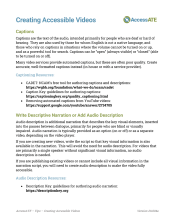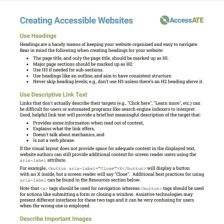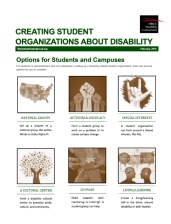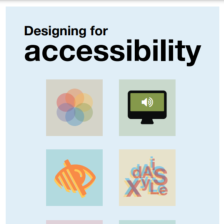Tools
Reference Material -- Nonfiction Reference
Resources | |
|---|---|
This tip sheet from the National Center for Accessible Media provides guidelines for creating accessible PDFs in both the source document and Adobe Acrobat. It covers topics like creating document structure, exporting, running accessibility checks, and images and alt text.
This tip sheet, provided by the WGBH Educational Foundation, includes guidance on creating accessible presentations. Tips are given for before, during, and after the presentation. The following are a few examples of the included tips:
Arrange for live captions.
Use good color contrast and large fonts in designing the slides,
Speak...
This webpage from the University of Washington describes a variety of ways for making video content accessible. "An accessible video includes captions, a transcript, and audio description and is delivered in an accessible media player." The webpage includes list of resources for captioning and audio description, including paid services,...
This tip sheet from the National Center for Accessible Media provides guidelines for creating accessible video content. It covers the topics of captioning, writing narrative descriptions, and choosing an accessible media player. The tip sheet also offers links to additional resources for creating captions and audio descriptions.
This tip sheet, created by the National Center for Accessible Media, provides guidelines for creating accessible websites. It covers the topics of headings, descriptive link text and button labels, image descriptions, colors and more. The tip sheet also offers links to additional resources for Web Content Accessibility Guidelines, and color...
This resource from the Historically Black Colleges and Universities (HBCU) Disability Consortium provides information for students and administrators who are interested in setting up a disability-related organization. Student group options and tips are highlighted. A list of national student groups is also provided.
This resource from the Historically Black Colleges and Universities (HBCU) Disability Consortium provides tips on providing culturally relevant disability services for African American students. Strategies for learning and personal growth, as well as a list of suggestions from HBCUs are provided.
This set of seven posters from Home Office Digital list the dos and don'ts for designing web materials for users: (1) on the autistic spectrum; (2) of screen readers; (3) with low vision; (4) with dyslexia; (5) with physical or motor disabilities; (6) who are deaf or hard of hearing; and (7) with anxiety.
This webpage, made available by Accessible Educational Materials (AEM) at Cast, Inc., describes one of the four qualities of an accessible user experience that are captured by the acronym POUR (Perceivable, Operable, Understandable, and Robust). The principles in Designing for Accessibility with POUR come from the Web Content Accessibility...
This webpage, made available by Accessible Educational Materials (AEM) at Cast, Inc., describes one of the four qualities of an accessible user experience that are captured by the acronym POUR (Perceivable, Operable, Understandable, and Robust). The principles in Designing for Accessibility with POUR come from the Web Content Accessibility...
| |
| ← Previous | Next → |









